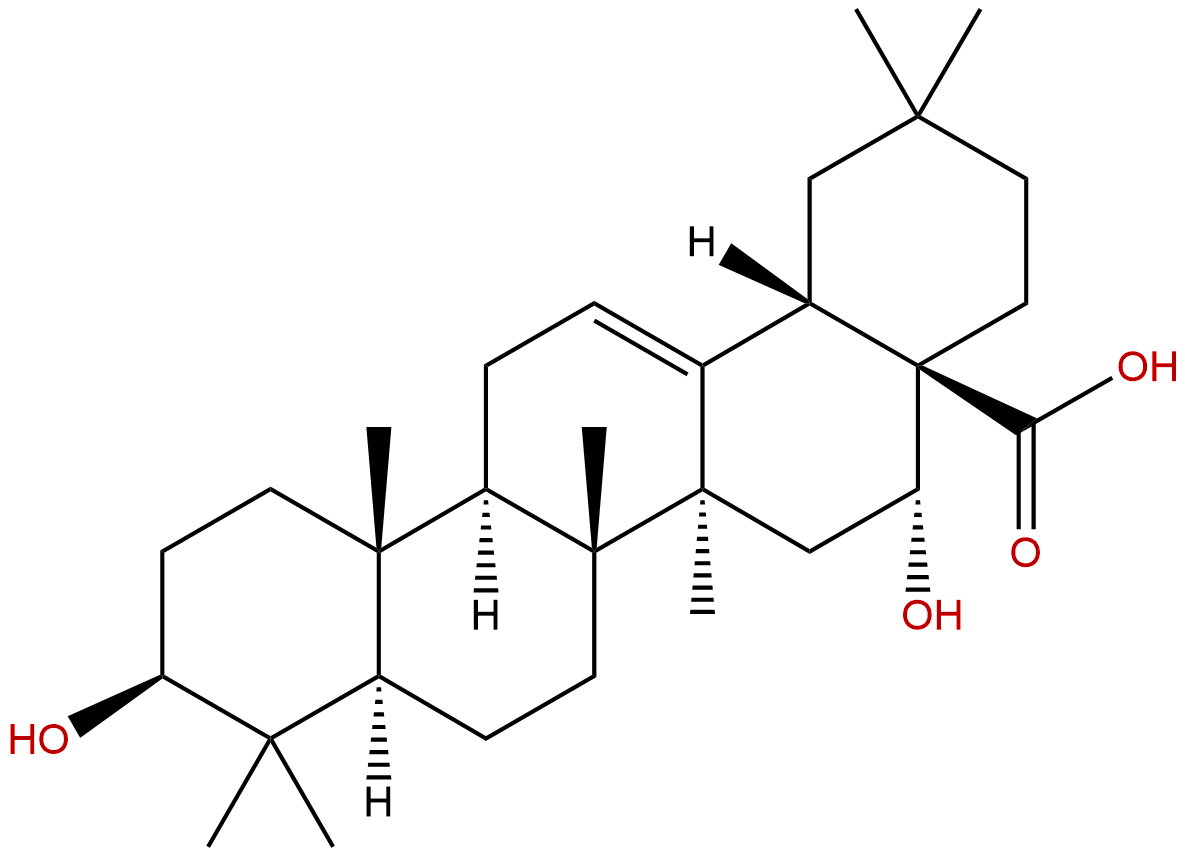
Echinocystic acidCAS No.:510-30-5 |
||||||||||
 |
|
|
||||||||

| Catalogue No.: | BP0522 |
| Formula: | C30H48O4 |
| Mol Weight: | 472.71 |
| Botanical Source: | Albizzia julibrissin Durazz. |
Product name: Echinocystic acid
Synonym name: Albizziagenin
Catalogue No.: BP0522
Cas No.: 510-30-5
Formula: C30H48O4
Mol Weight: 472.71
Botanical Source: Albizzia julibrissin Durazz.
Physical Description:
Type of Compound: Triterpenoids
Purity: 95%~99%
Analysis Method: HPLC-DAD or/and HPLC-ELSD
Identification Method: Mass, NMR
Packing: Brown vial or HDPE plastic bottle
Storage: Store in a well closed container, protected from air and light. Put into refrigerate or freeze for long term storage.
Whenever possible, you should prepare and use solutions on the same day. However, if you need to make up stock solutions in advance, we recommend that you store the solution as aliquots in tightly sealed vials at -20℃. Generally, these will be useable for up to two weeks.
The product could be supplied from milligrams to grams
Inquire for bulk scale.
Description:
Echinocystic acid has cardioprotective, hypolipidemic, anti-tumor, anti-inflammatory and antioxidant effects, it displays substantial inhibitory activity on HCV entry.Orally administered lancemaside A may be metabolized to echinocystic acid, which may be absorbed into the blood and ameliorate memory and learning deficits by inhibiting AChE activity and inducing BDNF and p-CREB expressions.Orally administered lancemaside A may be metabolized to echinocystic acid, which may be absorbed into the blood and ameliorate memory and learning deficits by inhibiting AChE activity and inducing BDNF and p-CREB expressions.
References:
Planta Med. 2013 Aug;79(12):1031-7
Echinocystic acid isolated from Eclipta prostrata suppresses lipopolysaccharide-induced iNOS, TNF-α, and IL-6 expressions via NF-κB inactivation in RAW 264.7 macrophages.[Pubmed: 23877917]
In this study, we aimed to identify the compounds in Eclipta prostrata responsible for its anti-inflammatory effects using an in vitro bioassay.
METHODS AND RESULTS:
Three triterpenoids, eclalbasaponin I, eclalbasaponin II, and Echinocystic acid, were isolated from an EtOAc fraction of the 70 % EtOH extract of E. prostrata by activity-guided fractionation based on the inhibition of nitric oxide release from lipopolysaccharide-induced RAW 264.7 macrophages. Of these three triterpenoids, Echinocystic acid inhibited lipopolysaccharide-induced production of nitric oxide and cytokines such as tumor necrosis factor-α and interleukin-6. Consistent with these observations, Echinocystic acid concentration-dependently inhibited lipopolysaccharide-induced inducible nitric oxide synthase expression at the protein level and inducible nitric oxide synthase, tumor necrosis factor-α, and interleukin-6 expression at the mRNA level, and inhibited lipopolysaccharide-induced iNOS promoter binding activity. In addition, Echinocystic acid suppressed the lipopolysaccharide-induced transcriptional activity of nuclear factor-κB by blocking the nuclear translocation of p65.
Life Sci. 2014 Oct 2;114(2):62-9.
Echinocystic acid, isolated from Gleditsia sinensis fruit, protects endothelial progenitor cells from damage caused by oxLDL via the Akt/eNOS pathway.[Pubmed: 25086379 ]
Our previous studies revealed that Echinocystic acid (EA) showed obvious attenuation of atherosclerosis in rabbits fed a high-fat diet. However, the underlying mechanisms remain to be elucidated. Considering the importance of endothelial progenitor cells (EPCs) in atherosclerosis, we hypothesise that EPCs may be one of the targets for the anti-atherosclerotic potential of EA.
METHODS AND RESULTS:
After in vitro cultivation, EPCs were exposed to 100 μg/mL of oxidised low-density lipoprotein (oxLDL) and incubated with or without EA (5 and 20 μM) for 48 h. An additional two groups of EPCs (oxLDL+20 μM EA) were pre-treated with either wortmannin, an inhibitor of the phosphoinositide 3-kinase (PI3K) pathway, or nitro-l-arginine methyl ester (l-NAME), an endothelial nitric oxide synthase (eNOS)-specific inhibitor. Assessment of EPC apoptosis, adhesion, migration, and nitric oxide (NO) release was performed using terminal deoxynucleotidyl transferase-mediated dUTP nick-end labelling (TUNEL) staining, cell counting, caspase-3 activity assay, transwell chamber assay, and Griess reagent, respectively. The protein expression of protein kinase B (Akt) and eNOS was detected using Western blot. Treatment of EPCs with oxLDL induced significant apoptosis and impaired adhesion, migration, and NO production. The deleterious effects of oxLDL on EPCs were attenuated by EA. However, when EPCs were pre-treated with wortmannin or l-NAME, the effects of EA were abrogated. Additionally, oxLDL significantly down-regulated eNOS protein expression as well as repression of eNOS and Akt phosphorylation.
CONCLUSIONS:
The inhibitory effect of oxLDL on Akt/eNOS phosphorylation was attenuated by EA. Taken together, the results indicate that EA protects EPCs from damage caused by oxLDL via the Akt/eNOS pathway.
Fitoterapia. 2010 Jan;81(1):8-10.
Protective effects of echinocystic acid isolated from Gleditsia sinensis Lam. against acute myocardial ischemia.[Pubmed: 19573579 ]
Echinocystic acid (EA), a pentacyclic triterpene, was isolated and identified from the fruits of Gleditsia sinensis Lam.
METHODS AND RESULTS:
The protective effects of EA were evaluated in rat models with acute myocardial ischemia induced by isoproterenol and vasopressin. In the electrocardiogram of anesthetized rats, EA prevented the ST-segment depression induced by isoproterenol or vasopressin in a dose-dependently manner. Furthermore, the mRNA expression of Bcl-2 was analyzed by RT-PCR. EA shows an elevation of Bcl-2 mRNA level in infarcted tissue induced by isoproterenol in rats.
CONCLUSIONS:
These results demonstrated for the first time EA has a cardioprotective effect and may be a natural drug.